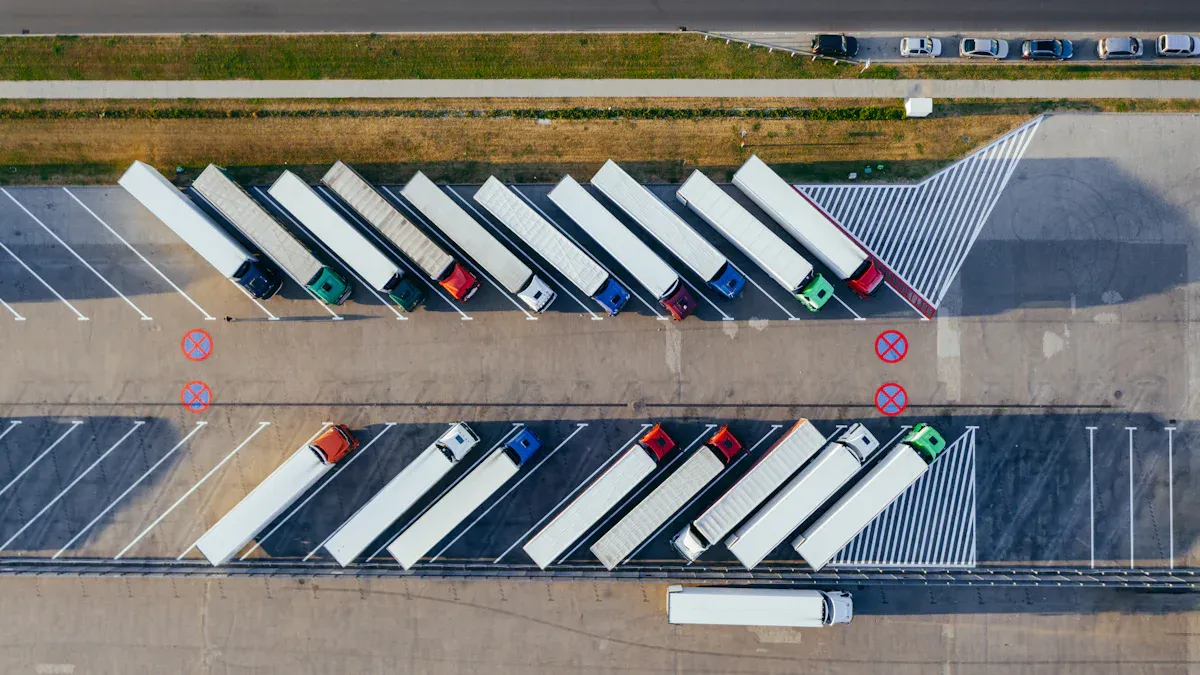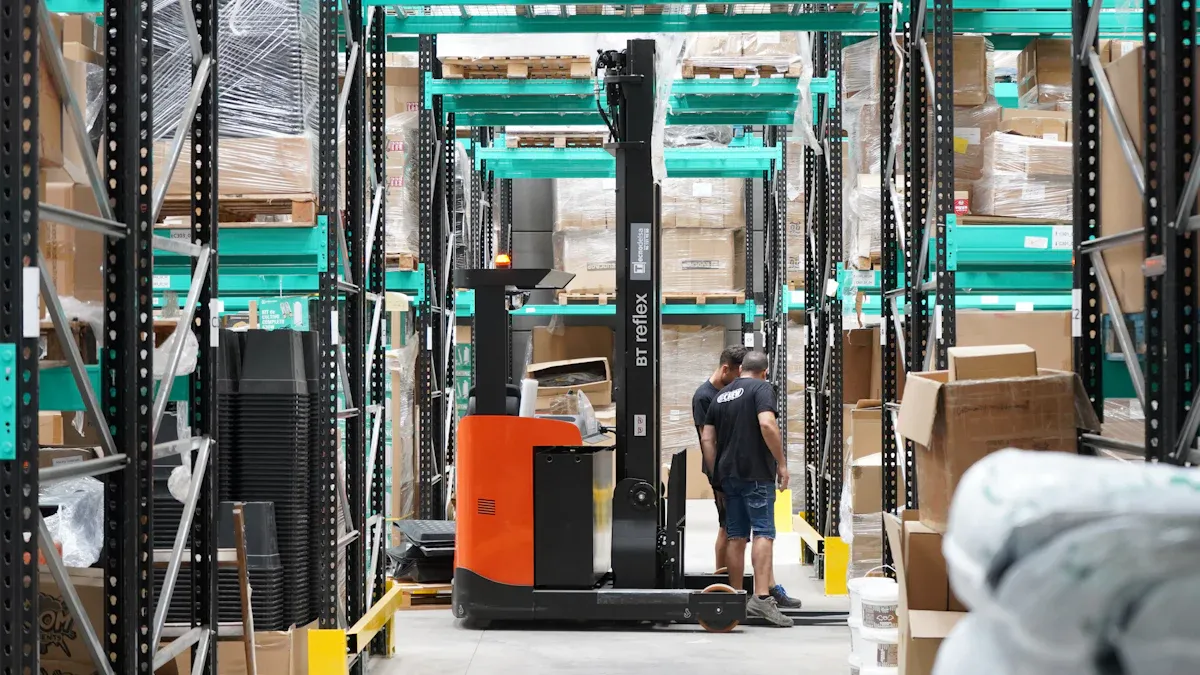How to Select the Best Logistics Tracking System for Your Business

When you pick a logistics tracking system, you can see your whole supply chain. The world’s logistics industry was worth over 8.4 trillion euros in 2021. Logistics costs are more than 10% of the world’s GDP. Real-time logistics tracking and tracing can make deliveries up to 30% faster. It can also lower costs by up to 25%.
Region | Key Logistics Trends |
|---|---|
North America | 79% of supply chains use advanced analytics. Tracking and tracing software saves 28% on fuel. |
Asia-Pacific | China’s logistics sector grew 9.1% in 2020. $1.4 trillion was spent on digital infrastructure. |
Japan | $7.5 billion was spent on smart logistics. Tracking and tracing systems cut inventory by 37%. |
You get an advantage when your logistics tracking matches your business goals. This match helps your business work better. It also brings clear value and helps your business grow. Advanced solutions like JUSDA’s give you the tools you need. They help you solve hard logistics problems.
Key Takeaways
Make sure your logistics tracking system fits your business goals. This helps you deliver faster, save money, and make customers happy.
Pick tracking software that gives updates right away. It should be easy to connect with other tools. Smart analytics help you understand your data. The system should grow with your business. This keeps your supply chain working well and able to change.
Connect your tracking system with transport management tools. This lets you see real-time data. You can make quick choices and give better service.
Identify Needs
Business Goals
You should know your business goals before picking a logistics tracking system. When your tracking technology matches your goals, you can see if things get better. You can check if delivery is faster, if orders are managed well, and if customers are happier. Set key performance indicators like how accurate deliveries are, how much things cost, and how fast inventory moves. These help you see how you are doing. This way, you can make better choices and make sure your tracking system helps your supply chain work better. Real-time tracking data helps you react fast to changes and lets customers see where their orders are.
Pain Points
Many logistics teams have problems that tracking systems can fix.
Critical Pain Point | Impact & Solution | Recommended Features |
|---|---|---|
Limited Visibility | Not seeing the supply chain well costs more and loses shipments. | Real-time tracking and AI-powered monitoring |
Siloed Operations | Data kept apart wastes time and causes mistakes. | Cloud-based solutions and real-time data sharing |
Manual Processes | Typing things in by hand makes mistakes and slows things down. | Automated data capture and processing |
Labor Shortages | Not enough workers slows down orders and deliveries. | Route optimization and automated scheduling |
Customer Dissatisfaction | Delays and no customer tracking make people unhappy. | GPS tracking and automated notifications |
Delivery Delays | Bad planning makes deliveries late. | AI-driven route optimization and real-time traffic |
Priorities
Focus on what makes things work better and keeps people happy.
Pick tracking systems that are simple to use and helpful.
Find features that save time, lower delivery costs, and help manage orders.
Make sure the system helps customers track their orders and feel good about your service.
Choose tracking solutions that can change to fit your needs and help your supply chain.
Tip: Easy-to-use tracking systems make customers happier and keep them coming back.
Logistics Tracking System Features

When you pick a logistics tracking system, look for features that help your business. You want a system that gives you control and saves time. It should also help you give better service. Let’s look at the most important features. Advanced platforms like JUSDA’s show what good logistics tracking should have.
Real-Time Tracking
Real-time tracking is very important for logistics tracking software. You need to know where your shipments are all the time. This feature lets you track shipments and drivers live. You get updates right away for every delivery. With real-time visibility, you can see delays and change routes fast. You can also keep customers updated.
Procter & Gamble used IoT and RFID for real-time tracking. They lowered inventory costs by 15%. They also made order fulfillment better by 10%.
Real-time tracking helps you see your inventory better. It makes lead times shorter and helps stop stockouts.
You can plan routes better and use resources well. This makes your logistics work smoother.
Customers trust you more when you give them correct shipment status and arrival times.
Real-time updates help you handle risks. You can change routes if there are problems.
JUSDA’s system uses IoT, cloud computing, and big data. It gives you real-time shipment tracking and better supply chain visibility. You get alerts right away, GPS delivery tracking, and notifications for every step.
Integration Capabilities
Integration capabilities help your logistics tracking software work with other systems. You want your tracking tools to connect with ERP, TMS, WMS, and customs platforms. This makes data flow easy and helps you make better choices.
Research shows that good integration with suppliers, trucking, warehousing, and 3PL partners makes delivery faster. It also saves money and makes customers happier.
Integrated systems let you share data in real time. This helps you work together and make better decisions.
Connecting with production planning and control systems lowers uncertainty. It also makes information more reliable.
JUSDA’s platform has open data interfaces and big data analysis. You can connect your tracking system with your other tools. This makes it easy to manage freight, inventory, and delivery schedules in one place. This level of integration helps you follow best practices and never miss an update.
Analytics & Reporting
Analytics and reporting turn your tracking data into useful information. You need dashboards, easy-to-use analytics, and clear reports to make smart choices.
Visualization tools help you see important metrics and trends right away.
Analytics like predictive and prescriptive analytics make operations better. They help with risk and customer service.
You can use these tools for route planning, maintenance, and demand forecasting.
AI and machine learning find hidden patterns and help automate decisions. This makes your tracking software smarter.
JUSDA’s system has advanced tracking and reporting tools. You can watch delivery performance and analyze order cycles. You can also find problems before they get worse. The analytics help you save money, move goods faster, and make customers happier.
Scalability
Scalability means your tracking system can grow with your business. You need a system that can handle more shipments, clients, and routes as you grow.
Scalable systems work for many types of transport and global operations. They help you enter new markets.
Modular growth keeps upgrade costs low and protects your investment.
Real-time tracking and automated notifications keep service quality high as you grow.
Open APIs and flexible user roles let you add vehicles, change reports, and connect with other systems.
JUSDA’s software is made to grow with you. You can add new warehouses, vehicles, or routes as your business gets bigger. The platform gives you better supply chain visibility and changes as you need it. This makes it a good choice for long-term success.
User Experience
User experience affects how your team and customers use the tracking system. A good platform makes tracking easy, clear, and reliable.
Customer surveys ask about delivery time, goods condition, and communication.
Net Promoter Score (NPS) shows how likely customers are to recommend you.
Best practices include real-time tracking, route planning, and flexible delivery.
Using feedback with key performance indicators helps you improve customer happiness and keep them coming back.
JUSDA’s software is easy to use. You get simple dashboards and easy tracking and reporting. Both your team and customers can track shipments in real time. The platform helps with customer tracking, returns, and clear communication. This builds loyalty and trust.
Note: If you pick a logistics tracking system with these features, your business will do better. JUSDA’s platform brings together real-time tracking, strong integration, smart analytics, scalability, and a great user experience. These are all based on the best ways to do logistics tracking.
Comparing Logistics Tracking Software
Cost & Value
When you look at logistics tracking software, check both price and value. A good system warns you early about problems. It helps you guess when deliveries will arrive. This lowers costs for logistics and inventory. You can plan better and keep less extra stock. You also avoid extra charges. Route optimization tools help you drive fewer miles. They save gas and keep vehicles in better shape. These tools make deliveries more reliable and cost less. Even small savings in tracking can really add up. That is because supply chain costs are a big part of your budget. Automated tracking and tracing help you use resources well and deliver better.
Vendor Support
Vendor support is very important for tracking software. You want a vendor who helps you meet delivery goals. They should keep your logistics running well. Good support means more on-time deliveries and lower costs. It also means better service. Vendors who use real-time data and analytics help you find problems fast. They help you fix issues quickly. They also help you track key performance indicators and make customers happier. Look for vendors who talk with you often and offer flexible solutions. They should give regular updates. JUSDA gives support, training, and upgrades to help you get the best from your tracking.
Security
Security is important in logistics tracking software. You must keep your data and shipments safe from threats. Modern systems use AI-powered video and real-time alerts to stop theft. They also help prevent insider crime. Centralized tracking and tracing give you more control and clear records. They lower risks from outside vendors. Secure tracking software keeps your information safe. It also builds trust with your customers. When you pick a system, check for strong security and proven results.
Future-Proofing
Future-proofing your tracking software helps your business handle change. New tools like AI, IoT, and blockchain make deliveries faster and clearer. They give you more control. These tools help you guess demand, plan routes, and manage inventory. Automation and robotics make deliveries faster and cut mistakes. Cloud-based tracking lets you grow without spending a lot. As online shopping grows, you need smart warehouses and real-time tracking to keep customers happy. JUSDA’s platform uses these new tools to keep your tracking up to date. The Sharp case shows that advanced tracking can save money, speed up deliveries, and make customers happier.
Implementation Best Practices
Planning
You need a good plan before starting your logistics tracking system. First, draw out your logistics steps and make flow charts. These charts help you see each part of your process. They also help you find problems and talk better with your team. Big companies like Maersk and DHL got better results with digital planning. Maersk worked faster by 30% after using data to plan. You should pick who does what, set delivery goals, and make a step-by-step plan for your software. JUSDA’s team helps you know what you need and matches the tracking system to your business.
Training
Training is very important for using new logistics tracking software. Workers sometimes worry about new tracking tools. You can help them by giving clear training and talking openly. Show your team how the system makes delivery better and their jobs easier. Use simple guides and real-life examples. JUSDA gives training and support to help your team learn the new software. Good training helps everyone feel sure and use the system well.
Measuring Success
You need to check how things go after using your new tracking software. Use clear numbers to see how fast orders are filled, how correct inventory is, and if deliveries are on time. Try to get over 95% on-time delivery and more than 98% inventory accuracy. Look at these numbers every month and change your process if needed. If many people use the system and mistakes go down, your tracking works well. JUSDA’s analytics tools help you watch these numbers and keep customers happy. Companies that use best practices for tracking get faster delivery, lower costs, and happier customers.
Transport Management System Integration

Seamless Operations
You need logistics tracking software that works well with your transport management system. When these tools connect, you see your shipments better. You also have more control over your deliveries. TMS software and tracking and tracing give real-time updates for every shipment. This helps you find delays and fix them quickly. You can plan the best routes for your trucks. Cloud-based TMS lets you manage orders and inventory from anywhere. JUSDA’s JusLink platform is an example of this. It brings together tracking software, TMS software, and smart warehousing. This makes order and delivery management easy.
Studies show companies with integrated TMS and tracking software deliver on time 95% of the time. They also get 25% better analytics. You can see where every shipment is and make smarter choices. Real-time tracking and tracing keep customers happy and lower costs. When you automate load planning, you use space better and save money. You also use resources better and work faster.
Data Flow
Good data flow is important for logistics tracking software and TMS software. All your systems need to share information. When you use tracking and tracing with TMS software, you get real-time data from sensors and GPS. Cloud-based TMS gives you up-to-date information. You can track shipments, check inventory, and plan routes easily.
If your data is stuck in silos, you miss important information. Integrated tracking software and TMS software fix this. You get better inventory accuracy and fewer lost sales. You also lower your costs. Real-time data makes route planning easier. You can change plans fast if there is bad weather or traffic. Best practices use standard data formats and strong security. JUSDA’s JusLink platform uses these ideas to keep your logistics smooth and your data safe.
Tip: Real-time data integration helps you make quick decisions. You make fewer mistakes and keep your customers happy.

JUSDA Solutions
To provide you with professional solutions and quotations.
Picking the best logistics tracking software means you need clear goals. You also need a good plan to use the software and keep checking how it works. When your logistics technology fits your needs, you make fewer mistakes. You spend less money and deliver things faster. Stories from real companies show that using tracking and tracing together helps a lot. To get the best results, look at options like JUSDA’s and learn from ways that have worked before.
Step | Benefit |
|---|---|
Assess capabilities | Faster delivery |
Integrate systems | Lower costs |
See Also
Key Reasons To Join Leading Logistics Webinars Today
Mastering Lean Logistics Strategies For Advanced Manufacturing
Comprehensive Overview Of Worldwide Logistics Firms Explained
Best Five Logistics Training Courses To Watch In 2024
How Robotics In Logistics Boost Warehouse Efficiency And Output
